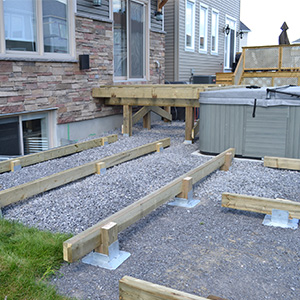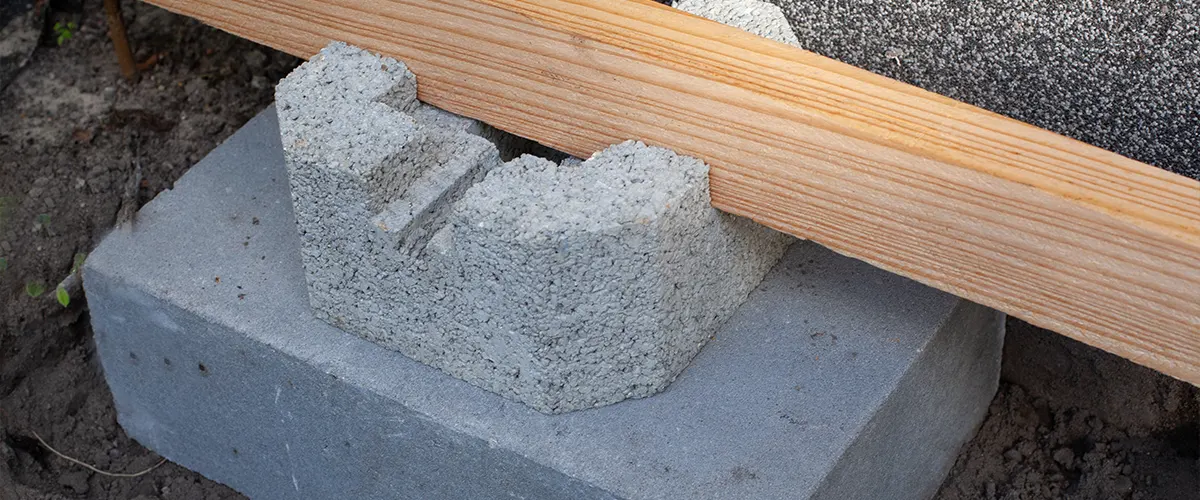Step-by-Step Deck Excellence: Guaranteeing Stability with Correctly Installed Deck Footings
Step-by-Step Deck Excellence: Guaranteeing Stability with Correctly Installed Deck Footings
Blog Article
Make Certain Stability and Longevity With Appropriately Installed Deck Grounds
Deck grounds might not be the most glamorous facet of deck construction, but they play a crucial role in guaranteeing stability and longevity. In this conversation, we will certainly explore the importance of proper deck grounds, variables to think about throughout installment, different types of grounds readily available, step-by-step installation overview, and maintenance ideas for making sure long-lasting grounds.

Relevance of Appropriate Deck Footings
Why are effectively installed deck footings crucial for the security and durability of your deck? Deck footings are the foundation on which the deck relaxes, transferring the tons from the deck to the ground.
Firstly, properly installed deck grounds distribute the weight of the deck equally, stopping any type of irregular settling or sinking. This is specifically vital in locations with unsteady soil, as it helps to mitigate the threat of the deck changing or falling down. Additionally, well-installed footings make sure that the deck remains level, protecting against any architectural damages that can occur when a deck ends up being unequal.
Secondly, effectively installed grounds provide a strong support for the deck, preventing excessive activity and persuade. This helps to keep the structural stability of the deck, minimizing the threat of accidents or injuries. It additionally decreases the wear and tear on the deck, enabling it to hold up against the aspects and regular use for a longer amount of time.
Factors to Consider for Deck Ground Installation
When installing deck footings, there are a number of important variables to consider for appropriate installation. These factors can considerably affect the stability and longevity of your deck. You need to establish the kind of dirt on which the deck will be built. Various dirt types have different load-bearing capacities, so it is crucial to carry out a soil test to make sure the footings can support the weight of the deck and its occupants. Additionally, the area and layout of the deck need to be very carefully planned to stay clear of any type of obstacles such as trees, utility lines, or below ground pipes. It is also crucial to consider the regional climate and weather, as these can influence the durability of the footings. Areas with a high water table might require additional actions to stop water damage. The dimension and product of the footings ought to be picked based on the dimension and weight of the deck, as well as the local building codes and guidelines. By thinking about these aspects, you can ensure the appropriate installation of deck grounds and take pleasure in a durable and stable deck.
Kinds of Deck Grounds to Pick From
There are a number of different kinds of deck grounds offered for you to choose from. Each type has its own benefits and drawbacks, so it's vital to consider your specific demands and the conditions of your deck prior to deciding.
One typical kind of deck ground is the concrete ground. This entails excavating openings in the ground and pouring concrete into them to create a strong structure. Concrete grounds are long lasting and provide exceptional stability, making them suitable for decks in locations with tough soil problems or high wind tons.
One more choice is the helical pier footing, which contains a steel shaft with helical plates that are screwed into the ground. These grounds are quick to mount and can be used in different soil types, consisting of sandy or clay dirts. They are likewise flexible, allowing for easy leveling of the deck.
Sonotube footings are another popular option. These grounds are produced by positioning a Look At This cardboard tube in a hole and loading it with concrete. Sonotube grounds are reasonably simple to mount and provide appropriate stability for smaller sized decks or in areas with less demanding dirt conditions.

When picking the kind of deck footing, it's important to think about variables such as dirt problems, deck size and weight, local building ordinance, and personal preferences. By choosing the appropriate footing kind, you can make certain the stability and long life of your deck.
Step-by-Step Overview for Installing Deck Footings

Figure out the area: Begin by noting the precise position of resource each footing utilizing risks and string (Deck Footings). Consider any neighborhood building ordinance or policies relating to trouble distances
Dig the holes: Utilize a blog post hole miner or an auger to dig the openings for the footings. Normally, a deepness of at the very least 36 inches is advised for stability.
Level the holes: Ensure that the bottoms of the openings are level (Deck Footings). This can be achieved by making use of a level or a straight board across the top of the holes
Include gravel: Location a layer of crushed rock at the end of each hole to boost water drainage and prevent the footing from sinking into the dirt gradually.
Place the footing types: Place the ground develops into the openings, ensuring they are focused and degree. Use stakes to safeguard them in place.
Mix and put concrete: Comply with the instructions on the concrete mix bag to prepare the concrete. Pour the concrete right into the footing forms, filling them entirely.
Smooth the surface: Utilize a trowel to smooth the surface area of the concrete and eliminate any air pockets. Enable the concrete to this content heal according to the producer's instructions.
Upkeep Tips for Durable Deck Grounds
Correct upkeep is vital for guaranteeing the long life and security of deck footings. By regularly examining and preserving your deck footings, you can stop damage and prospective safety hazards.
Routine cleansing is likewise necessary for preserving deck grounds. Plant life, dirt, and particles can accumulate around the footings, which can bring about moisture build-up and decay. Cleaning the grounds frequently, making use of a brush or a pressure washer, can help stop these problems and extend the life-span of your deck.
In addition to cleaning, it is essential to maintain the location around the grounds clear of any obstructions. Avoid piling things versus the grounds or allowing plants to grow too near to them. These blockages can catch wetness and create the grounds to wear away over time.
Lastly, regular resealing of the footings is recommended to safeguard them from wetness and other environmental factors. Applying a water resistant sealer can assist stop water damages and prolong the life expectancy of the footings.
Final Thought
Finally, appropriate setup of deck footings is vital for making certain stability and durability of your deck. Elements such as soil kind, lots ability, and regional building ordinance need to be considered when choosing the appropriate kind of deck grounds. Complying with a step-by-step overview for installation and regular upkeep will certainly assist to make sure the footings remain durable and durable.
In this discussion, we will discover the value of proper deck grounds, variables to take into consideration throughout installation, various kinds of footings readily available, detailed installation overview, and maintenance tips for making certain durable footings. Deck grounds are the foundation on which the deck relaxes, transferring the load from the deck to the ground.One typical type of deck ground is the concrete footing. Put the ground types: Insert the ground forms right into the holes, guaranteeing they are centered and degree.In final thought, proper setup of deck footings is critical for making sure stability and long life of your deck.
Report this page